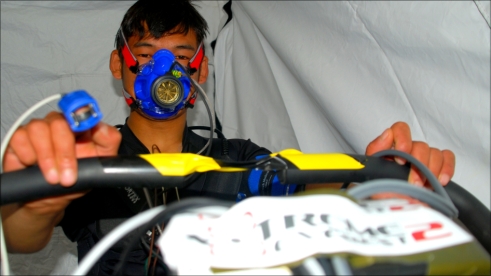A new systematic review paper by Xtreme Everest doctors has recently been published in Sports Medicine. Entitled Genetic Factors Associated with Exercise Performance in Atmospheric Hypoxia the article reviews studies which looked at the association of genetic factors with exercise performance at altitude.
It has long been shown that ‘natural selection’ enriches the genomes of high-altitude native populations (such as Sherpas) with genetic variants of advantage in this hostile hypoxic environment. Inlowlanders who ascend to altitude genetic factors may also contribute to the substantial interindividual variation in exercise performance. The purpose of the systematic review was to identify genetic variants of possible influence on human hypoxic exercise performance.
The team, consisting of Dr Phil Hennis, Mr Alasdair O'Doherty, Dr Denny Levett, Professor Mike Grocott and Professor Hugh Montgomery, undertook a systematic literature review which assessed 307 studies. Eleven studies in total met all the inclusion criteria that were set by the group and were reviewed in full.
It was found that four genetic polymorphisms were were associated with hypoxic exercise performance. The angiotensin I-converting enzyme (ACE) insertion/deletion (I/D) polymorphism had the most supporting literature, with three studies observing an association between the I allele (lower ACE activity) and better mountaineering performance. In addition, study quality analysis highlighted deficiencies in the conduct and reporting of the genetic association studies in this field.
From the review, the group summarised that due to lack of research in this field firm conclusions could not being drawn about which genetic polymorphisms are associated with altered exercise performance at high altitude. . It was however shown that support for the association between the ACE-I allele and improved high altitude performance was the strongest.. The review highlighted that this area of research has not been studied in great depth and that the quality of research was not optimal. The review also concluded that there is a need for future studies in this field to improve the conduct and reporting of genetic association studies and for researchers to consider using genome wide studies in order to help identify novel biological pathways of hypoxic adaptation.
To read the full review you can download a copy here ![]() Hennis et al Genetic factors associated with exercise performance in atmospheric hypoxia 2015 online version.pdf (357 KB)
Hennis et al Genetic factors associated with exercise performance in atmospheric hypoxia 2015 online version.pdf (357 KB)
The review was undertaken by the following Xtreme Everest members:
- P. J. Hennis & D. Z. H. Levett & M. P. W. Grocott & H. M. Montgomery
UCLH NIHR Biomedical Research Centre, Institute of Sport Exercise Health (ISEH), University College London Centre for Altitude Space and Extreme Environment Medicine (CASE)
- A. F. O̢۪Doherty
Department of Sport, Health and Exercise Science, University of Hull, Hull, UK
- D. Z. H. Levett & M. P. W. Grocott
Integrative Physiology and Critical Illness Group, Clinical and Experimental Sciences, Sir Henry Wellcome Laboratories, Faculty of Medicine, University of Southampton, University, Hospital Southampton NHS Foundation Trust, Southampton, UK
- D. Z. H. Levett & M. P. W. Grocott
Anaesthesia and Critical Care Research Unit, University Hospital Southampton NHS Foundation Trust, Southampton, UK
- D. Z. H. Levett & M. P. W. Grocott
NIHR Southampton Respiratory Post a comment on this article...
Post a comment on this article...




